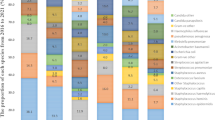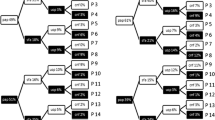Abstract
Escherichia coli was the most frequent species isolated from blood cultures in the Hospital Covadonga of Oviedo (Spain) over a six-year period (474 episodes, 15.3 % of the total septicemias and 2.7 episodes per 1,000 patients).Escherichia coli strains were susceptible in >95 % of episodes to cefoxitin, cefotaxime, gentamicin, tobramicin and amikacin. In a series of 72 episodes, microbiological features and host factors were studied. No endemic strains were found. Type 1 fimbria was detected in 73.6% of strains and P-fimbriae in 12.5 %, without correlation between P-fimbria and urinary infection; 84.7 % of the strains were resistant to decomplement human serum; 61.1 % produced aerobactin and 20.8 % were hemolytic. Factors such as age, hospital location, metastatic focus and surgical treatment were significantly correlated with morbidity and mortality. The global mortality rate was 18 %, and in 8.3 % of cases was directly associated with septicemia.
Similar content being viewed by others
References
Sussman M:Escherichia coli in human and animal disease. In: Sussman M (ed): The virulence ofEscherichia coli. Reviews and methods. Academic Press, London, 1985, p. 7–45.
Fidalgo S, Vázquez F, Mendoza MC, Pérez F, Méndez FJ: Bacteremia due toStaphylococcus epidermidis: microbiologic, epidemiologic, clinical, and prognostic features. Reviews of Infectious Diseases 1990, 12: 520–528.
Kreger BE, Craven DE, Carling PC, McCabe WR: Gram-negative bacteremia. III: Reassessment of etiology, epidemiology and ecology in 612 patients. American Journal of Medicine 1980, 68: 332–343.
McGowan JE, Barnes MW, Finland M: Bacteremia at Boston city hospital: occurrence and mortality during 12 selected years (1935–1972), with special reference to hospital-acquired cases. Journal of Infectious Diseases 1975, 132: 316–335.
Harris RL, Musher DM, Bloom K, Gathe J, Rice L, Sugarman B, Williams TW, Young EJ: Manifestations of sepsis. Archives of Internal Medicine 1987, 147: 1895–1906.
Grupo de estudio de la bacteriemia: Bacteriemia en seis hospitales españoles. Medicina Clínica 1986, 86: 221–232.
Ørskov F, Ørskov I: Serotyping ofEscherichia coli. In: Bergan T (ed): Methods in microbiology. Volume 14. Academic Press, London, 1984, p. 43–112.
Buckwold FJ, Ronald AR, Harding GKM, Marrie TJ, Fox L, Cates C: Biotyping ofEscherichia coli by a simple multiple-inoculation agar plate technique. Journal of Clinical Microbiology 1979, 10: 275–278.
Bauer AW, Kirby WMM, Sherris JC, Turck M: Antibiotic susceptibility testing by a standardized single disk method. American Journal of Clinical Pathology 1966, 45: 493–496.
Amsterdam D: The new NCCLS susceptibility documents. Antimicrobial Newsletter 1989, 6: 1–8.
Harnett NM, Gyles CL: Resistance to drugs and heavy metals, colicin production, and biochemical characteristics of selected bovine and porcineEscherichia coli strains. Applied Environmental Microbiology 1984, 48: 930–935.
Vázquez F, Fidalgo S, Méndez FJ, Mendoza MC: Resistance to antibiotics and inorganic ions in virulent bacterial strains from a hospital. Journal of Chemotherapy 1989, 1: 233–239.
Birnboim HC, Doly J: A rapid alkaline extraction procedures for screening recombinant plasmid DNA. Nucleic Acids Research 1979, 7: 1513–1523.
Marre R, Hacker J, Henkel W, Goebel W: Contribution of cloned virulence factors from uropathogenicEscherichia coli strains to nephropathogenicity in an experimental rat pyelonephritis model. Infection and Immunity 1986, 54: 761–767.
Williams PH: Novel iron uptake system specified by Col V plasmids: an important component in the virulence of invasive strains ofEscherichia coli. Infection and Immunity 1979, 26: 925–932.
Svenson SB, Källenius G, Möllby R, Hultberg H, Winberg J: Rapid identification of P-fimbriatedEscherichia coli by a receptor-specific particle agglutination test. Infection 1982, 10: 209–214.
Small PLC, Falkow S: Identification of regions on a 230-kilobase plasmid from enteroinvasiveEscherichia coli that are required for entry into HEp-2 cells. Infection and Immunity 1986, 56: 225–229.
Bhaduri S, Conway LK, Lachica RV: Assay of crystal violet binding for rapid identification of virulent plasmid-bearing clones ofYersinia enterocolitica. Journal of Clinical Microbiology 1987, 25: 1039–1042.
Kandolo K, Wauters G: Pyrazinamidase activity inYersinia enterocolitica and related organisms. Journal of Clinical Microbiology 1985, 21: 980–982.
Day NP, Scotland SM, Rowe B: Comparison of an HEp-2 tissue culture test with the Sereny test for detection of enteroinvasiveness inShigella spp. andEscherichia coli. Journal of Clinical Microbiology 1981, 13: 596–597.
Montgomerie JZ, Bindereif A, Neilands JB, Kalmanson GM, Guze LB: Association of hydroxamate siderophore (aerobactin) withEscherichia coli isolated from patients with bacteremia. Infection and Immunity 1984, 46: 835–838.
Carbonetti NH, Williams PH: Detection of synthesis of the hydroxamate siderophore aerobactin by pathogenic isolates ofEscherichia coli. In: Sussman N (ed): The virulence ofEscherichia coli. Academic Press, London, 1985, p. 419–423.
Bindereif A, Neilands JB: Aerobactin genes in clinical isolates ofEscherichia coli. Journal of Bacteriology 1985, 161: 727–735.
Maniatis T, Fritsch EF, Sambrook J: Molecular cloning: a laboratory manual. Gold Spring Harbor Laboratory, Cold Spring Harbor, New York, 1982.
Nordic Council on Medicines: Nordic statistics on medicines 1981–1983. II: Nordic drugs index with classification and defined daily doses. Uppsala, 1985.
Hunter PR, Gaston MA: Numerical index of the discriminatory ability of typing systems: an application of Simpson's index of diversity. Journal of Clinical Microbiology 1988, 26: 2465–2466.
Filice GA, van Ettal LL, Darby CP, Fraser DW: Bacteremia in Charleston County, South Carolina. American Journal of Epidemiology 1985, 123: 128–136.
McCabe WR: Gram-negative bacteremia: a physician's overview. In: Sanford JP (ed): Gram-negative sepsis. Medeom, New York 1971, p. 165–178.
Gransden WR, Eykyn SJ, Phillips I, Rowe B: Bacteremia due toEscherichia coli: a study of 861 episodes. Reviews of Infectious Diseases 1990, 12: 1008–1018.
Kreger BE, Craven DE, McCabe WR: Gram-negative bacteremia. IV. Reevaluation of clinical features and treatment in 612 patients. American Journal of Medicine 1980, 68: 344–345.
Brauner A, Leissner M, Wretlind B, Julander I, Svenson SB, Källenius G: Occurrence of P-fimbriatedEscherichia coli in patients with bacteremia. European Journal of Clinical Microbiology 1985, 4: 566–569.
Svanbom M: A prospective study on septicemia. II: Clinical manifestations and complications, results of antimicrobial treatment and report of a follow-up study. Scandinavia Journal of Infectious Diseases 1980, 12: 189–206.
O'Brien TF: Members of task force 2. Resistance of bacteria to antibacterial agents: report of task force 2. Reviews of Infectious Diseases 1987, 9, Supplement 3: 244–260.
Julander I: Septicemia and endocarditis, 1965–1980, in a Swedish university hospital for infectious diseases. Infection 1987, 15: 177–183.
Cravioto A, Scotland SM, Rowe B: Haemagglutination activity and colonization factor antigens I and II in enterotoxigenic and non-enterotoxigenic strains ofEscherichia coli isolated from humans. Infection and Immunity 1982, 36: 189–197.
Finlay BB, Falkow S: Common themes in microbial pathogenicity. Microbiological Reviews 1989, 53: 210–230.
Martínez JC, Cercenado E, Pérez-Díaz JC, Baquero F: Multifactorial determination of systemic invasivity inEscherichia coli. FEMS Microbiology Letters 1986, 37: 259–261.
Agüero ME, Cabello FC: Relative contribution of Col V plasmids and K1 antigen to the pathogenicity ofEscherichia coli. Infection and Immunity 1983, 40: 359–368.
Korhonen TK, Valtonen MV, Parkinen J: Serotypes, hemolysin production and receptor recognition ofEscherichia coli strains associated with neonatal sepsis and meningitis. Infection and Immunity 1985, 48: 486–491.
Montgomery JZ, Bindereif A, Neilands JB, Kalmanson GM, Guze LB: Association of hydroxamate siderophore withEscherichia coli isolated from patients with bacteremia. Infection and Immunity 1984, 46: 835–838.
Johnson JR, Moseley SL, Roberts PL, Stamm WE: Aerobactin and other virulence factor genes among strains ofEscherichia coli causing urosepsis: association with patient characteristics. Infection and Immunity 1988, 56: 405–412.
Carbonetti NH, Boonchai S, Parry SH, Väisänen-Rhen V, Korhonen TK, Williams PH: Aerobactin-mediated iron uptake byEscherichia coli isolates from human extraintestinal infections. Infection and Immunity 1986, 51: 966–968.
Opal SM, Cross AS, Gemski P, Lythe LW: Aerobactin and α-hemolysin as virulence determinants inEscherichia coli isolated from human blood, urine, and stool. Journal of Infectious Diseases 1990, 161: 794–796.
Smith HW, Huggins MB: Further observations on the association of the colicine V plasmid ofEscherichia coli with pathogenicity and with survival in the alimentary tract. Journal of General Microbiology 1976, 92: 335–350.
Author information
Authors and Affiliations
Rights and permissions
About this article
Cite this article
Vázquez, F., Mendoza, M.C., Viejo, G. et al. Survey ofEscherichia coli septicemia over a six-year period. Eur. J. Clin. Microbiol. Infect. Dis. 11, 110–117 (1992). https://doi.org/10.1007/BF01967061
Issue Date:
DOI: https://doi.org/10.1007/BF01967061




